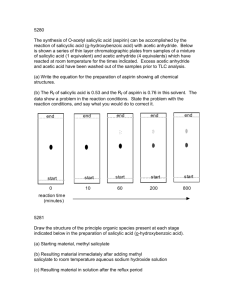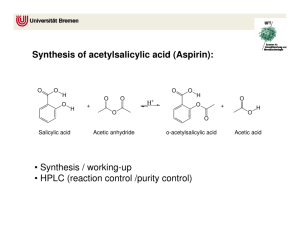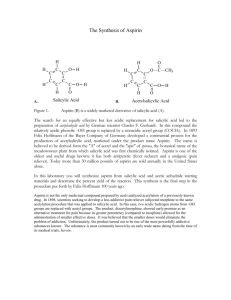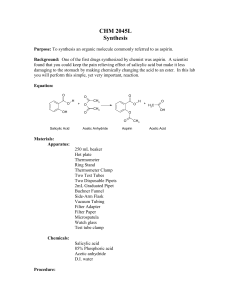Synthesis of Aspirin Notes
advertisement
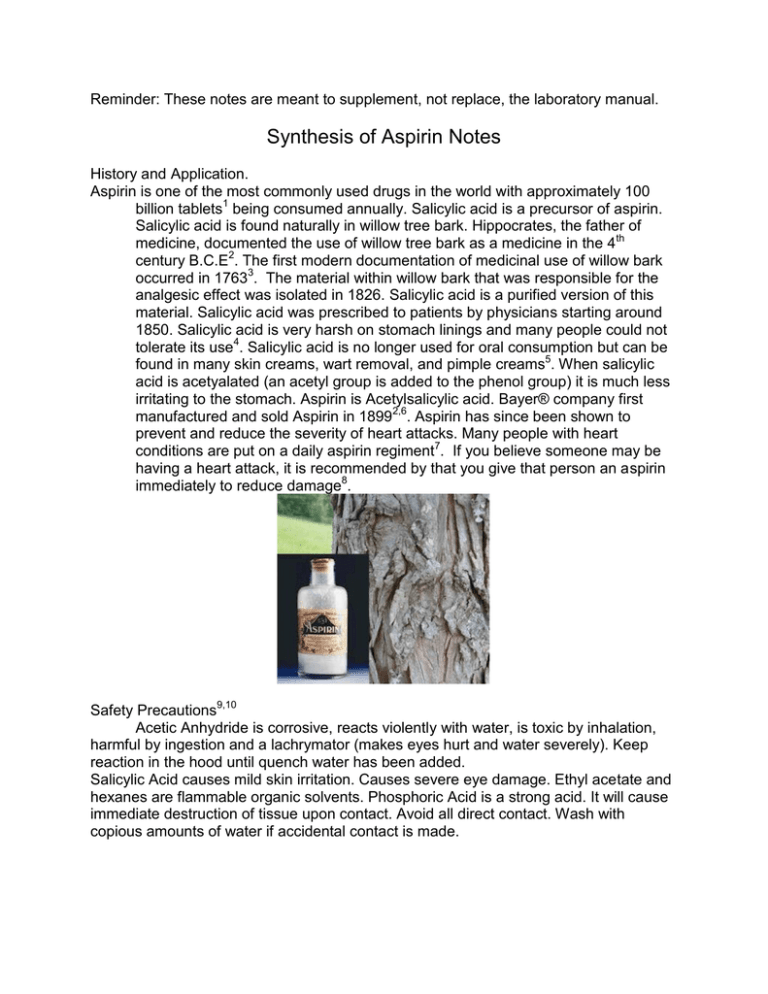
Reminder: These notes are meant to supplement, not replace, the laboratory manual. Synthesis of Aspirin Notes History and Application. Aspirin is one of the most commonly used drugs in the world with approximately 100 billion tablets1 being consumed annually. Salicylic acid is a precursor of aspirin. Salicylic acid is found naturally in willow tree bark. Hippocrates, the father of medicine, documented the use of willow tree bark as a medicine in the 4 th century B.C.E2. The first modern documentation of medicinal use of willow bark occurred in 17633. The material within willow bark that was responsible for the analgesic effect was isolated in 1826. Salicylic acid is a purified version of this material. Salicylic acid was prescribed to patients by physicians starting around 1850. Salicylic acid is very harsh on stomach linings and many people could not tolerate its use4. Salicylic acid is no longer used for oral consumption but can be found in many skin creams, wart removal, and pimple creams5. When salicylic acid is acetyalated (an acetyl group is added to the phenol group) it is much less irritating to the stomach. Aspirin is Acetylsalicylic acid. Bayer® company first manufactured and sold Aspirin in 18992,6. Aspirin has since been shown to prevent and reduce the severity of heart attacks. Many people with heart conditions are put on a daily aspirin regiment7. If you believe someone may be having a heart attack, it is recommended by that you give that person an aspirin immediately to reduce damage8. Safety Precautions9,10 Acetic Anhydride is corrosive, reacts violently with water, is toxic by inhalation, harmful by ingestion and a lachrymator (makes eyes hurt and water severely). Keep reaction in the hood until quench water has been added. Salicylic Acid causes mild skin irritation. Causes severe eye damage. Ethyl acetate and hexanes are flammable organic solvents. Phosphoric Acid is a strong acid. It will cause immediate destruction of tissue upon contact. Avoid all direct contact. Wash with copious amounts of water if accidental contact is made. 1. In this experiment salicylic acid will be acetylated by acetic anhydride and acetyl salicylic acid, aspirin, will be formed11. Here is the balanced equation for the reaction: Salicylic Acid is o-hydoxy benzoic acid. This compound has both a phenol functional group and a carboxylic acid. Acetic anhydride is an anhydride. Aspirin contains a carboxylic acid group and an ester. Acetic acid is a carboxylic acid. Phosphoric acid is a mineral acid and is added as a catalyst. 2. After the reaction is complete, water is added to quench (destroy) any remaining acetic anhydride and turn it into acetic acid. The water adds across the anhydride bridge, cleaving it, and releasing two acetic acid molecules. Acetic acid is much less reactive than acetic anhydride. 3. Solubility. Both salicylic Acid and aspirin are slightly soluble in water at room temperature (~0.2 g/100mL). A minimum of water needs to be used in order to induce the product aspirin to precipitate out of solution as a solid. The solution will be iced after crystals start to form to reduce solubility of the product in the water further and increase the percent yield. 4. The solids recovered after the reaction has been carried out will be analyzed by TLC. The solvent that will be used will be 50 % ethyl acetate 50 % hexanes12. If you have forgotten how to set up, develop, calculate Rf, or interpret TLC, then re-read the on-line notes relating to TLC from 2230L. Note, you will be asked to spot the starting salicylic acid, a co-spot, and the product on a TLC. A co-spot is where both reactant and product is spotted at the exact same location. This is beneficial when both reactant and product have a similar Rf. 13 5. Mechanism14: Phosphoric acid is added as a catalyst. It is a strong acid (pKa ~2.1) and there are many available protons. Concentrated phosphoric acid is 85% wt H3PO4 in water. The synthesis is acid catalyzed. First there is a reversible reaction in which the oxygen of the carbonyl of the acetic anhydride is protonated. This increases the electrophilicity of the carbon of that carbonyl. The oxygen of the phenol is much more nucleophilic than the oxygen of the carboxylic acid. The oxygen of the phenol group acts as a nucleophile and attacks the carbon of the carbonyl within acetic anhydride and simultaneously breaks the bond to oxygen. This forms a tetrahedral intermediate. A series of proton transfers occur. The electrons on the oxygen of the hydroxyl group on the tetrahedral intermediate, ultimately come down and reform a carbonyl group, this simultaneously induces an acetic acid to leave. After one additional proton transfer, the final aspirin is formed. 6.Purity. The chemical structure of the acetylsalicylic acid we produce in the lab is identical to the structure of the acetylsalicylic acid found in commercial aspiring tablets. What is the difference between the solid we produce in lab and aspirin tablets? It is highly ill advised to eat the solid formed from this experiment. Why? Reviewed February 11, 2016 (slweaver) References: 1. The 17 molecules that changed the world, http://www.cosmosmagazine.com/news/2403/17-molecules-altered-human-historymolecules-changed-wold (March 19, 2011) 2.History of Aspirin, http://www.wonderdrug.com/pain/asp_history.htm (March 19, 2011) 3. The Discovery of Aspirin's Antithrombotic Effects, Jonathan Miner, BS, BA and Adam Hoffhines, BS, http://www.ncbi.nlm.nih.gov/pmc/articles/PMC1894700/ (March 19, 2011) 4 Inventor Hoffman http://www.chemheritage.org/discover/chemistry-inhistory/themes/pharmaceuticals/relieving-symptoms/hoffmann.aspx (March 19, 2011) 5.Drug information on-line, Salicylic Acid, http://www.drugs.com/pro/salicylic-acid.html (March 19, 2011) 6. History of Bayer, http://www.bayer.com/en/1881-1914.aspx (March 19, 2011) 7. Daily Aspirin, Mayo Clinic, http://www.mayoclinic.com/health/daily-aspirintherapy/HB00073 , (march 19, 2011) 8. Why do Paramedics give aspirin to patients before they reach the hospital? Why is Aspirin so important?, Harlan Kromholz, M.D., S.M.,Harold H. Hines, Jr. Professor of Medicine and Epidemiology and public health, Yale University, Yale University School of Medicine, http://abcnews.go.com/Health/HeartDiseaseTreatment/story?id=4223052 (March 19, 2011) 9. Sigma-Aldrich MSDS of Acetic Anhydride http://www.sigmaaldrich.com/catalog/DisplayMSDSContent.do (March 19, 2011) 10. Sigma Aldrich MSDS of Salicylic Acid. http://www.sigmaaldrich.com/catalog/DisplayMSDSContent.do (March 19, 2011) 11. Crago, K., DiMaggio, S., Foroozesh, M., Giannamore, V., Goloverda, G.,Jordan, Tl, Morgan, K., Polito, M., Politzer, I., Ross, T., Sevenair, J., Organic Chemistry Laboratroy Manual, 6th Ed; Wiley Custom: Hoboken NJ, 2006, p 94-96 12. Clark F. Most, Experimental Organic Chemistry, Wiley 1988, p 87 13. 1 The Synthetic Organic Chemist’s Companion, Michael Pirrung, Wiley, Hoboken, 2007, p96 14. Past on-line lecture notes, Synthesis of Aspirin, http://www.xula.edu/chemistry/documents/orgleclab/24Aspirin.pdf (March 18, 2011)
